Affiliate links on Android Authority may earn us a commission. Learn more.
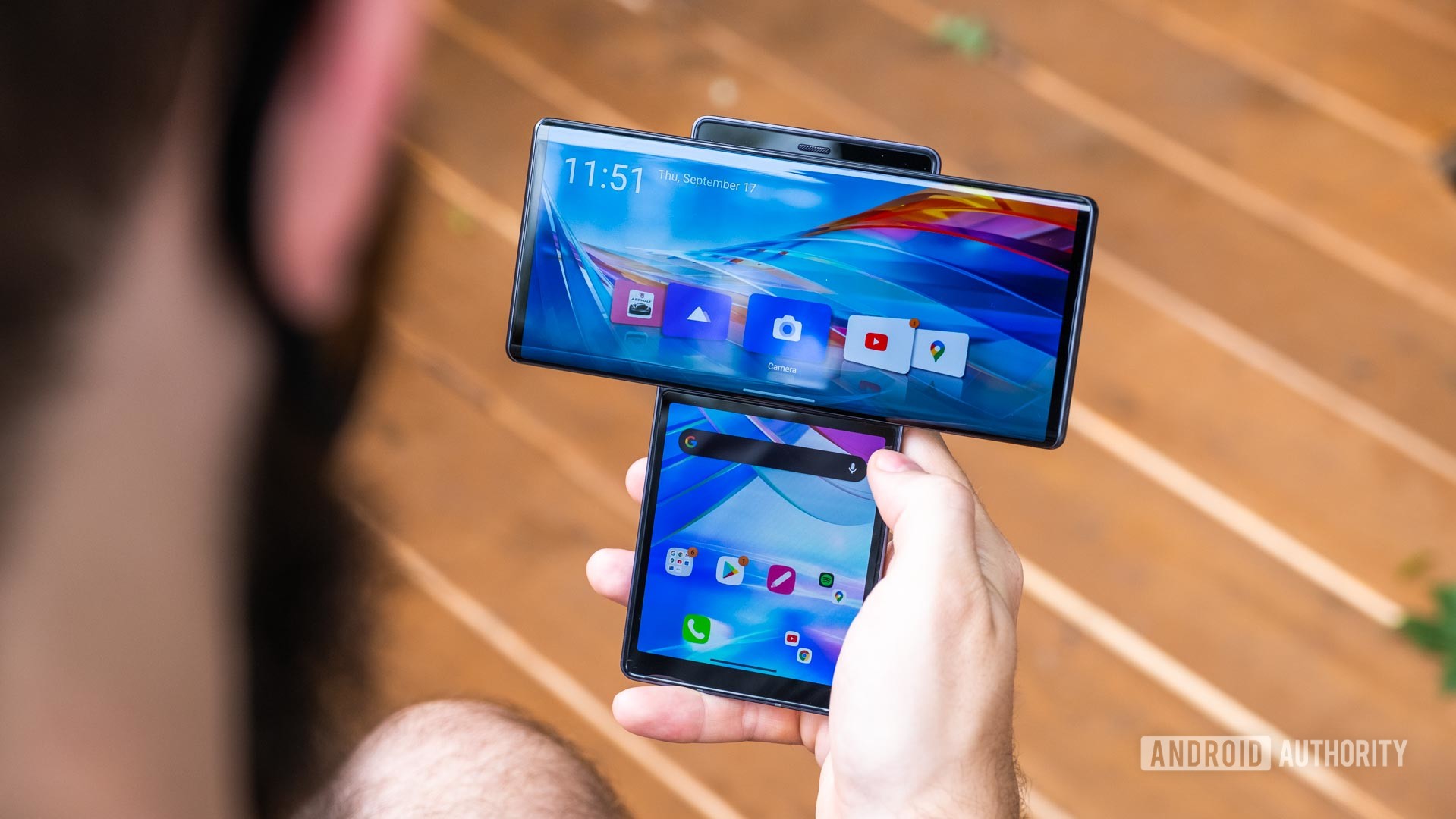
LG Wing review: An incredible first try, but a first try nonetheless
Published onSeptember 17, 2022
LG Wing
What we like
What we don't like
Our scores
LG Wing
Smartphones have become boring. If you walk into a shop, you’ll see nothing but black glass slates along the wall. They all look pretty much the same. You begin to wonder if smartphone OEMs are even trying anymore.
Enter the LG Wing, the first phone in LG‘s new Explorer Project, which aims to experiment with new smartphone form factors and features. The swivel phone with two displays is unlike anything we’ve seen on a modern smartphone. It opens up brand new use cases, gives videographers a powerful new tool for their gear bag, and could be the form factor mobile gamers never knew they wanted.
Of course, it takes more than a nifty new trick and some plausible use cases for a phone to be a hit. The big question hanging over the Wing is whether or not it will make those potential abilities work well enough for buyers to fall in love with it.
In this LG Wing review, I’ll do my best to answer that question.
Design: Unlike anything else
- Gorilla Glass 5 front and rear
- 169.5 x 74.5 x 10.9mm
- 260g
- In-display fingerprint sensor
- Pop-up selfie camera
- USB-C
- microSD card slot
- Bottom-firing loudspeaker
- No 3.5mm port
- Aurora Gray / Illusion Sky colorways
When you take the LG Wing out of the box, it looks the same as any other 2020 smartphone. Sure, it’s a little thicker and a lot heavier than most devices, but the usual design elements are all there: tall glass panel with curved sides, glossy glass back with a huge multi-lens camera bump, USB-C port, no headphone jack, etc.
Even when you first power on the phone, it doesn’t seem out of the ordinary in any way. It’s only when you push the display out from the bottom right and expose the mini-display underneath that you realize what you have in your hands. With the display fully extended, you’ve exited “Basic Mode” and entered “Swivel Mode.”
What’s most remarkable about the LG Wing is how well its design works in both modes. If you can ignore the weight and thickness, using the phone in Basic Mode felt like using most other giant phones of the year, such as the Samsung Galaxy Note 20 Ultra. In fact, the rear camera module even looks a lot like that of the Note 20 Ultra.
When extended into Swivel Mode, the phone works as well as you could hope. Swiveling the display is incredibly smooth and satisfying. Whether opening or closing it, the display glides along with the chassis before making a satisfying pop sound as it locks into place. Once it’s opened up, gripping the phone from the bottom feels natural. The weight is evenly distributed. The bottom half of the phone is competently constructed, so you don’t feel like you could crush the whole thing in your grip.
For the record, LG claims you can swivel the Wing 200,000 times before any significant problems occur. That’s enough to allow you to swivel back-and-forth 30 times a day for over nine years.
When in Swivel Mode, the back of the main display is exposed. LG added a dot matrix design here that looks pretty classy. It is a nice touch even if you won’t see it too often in regular use.
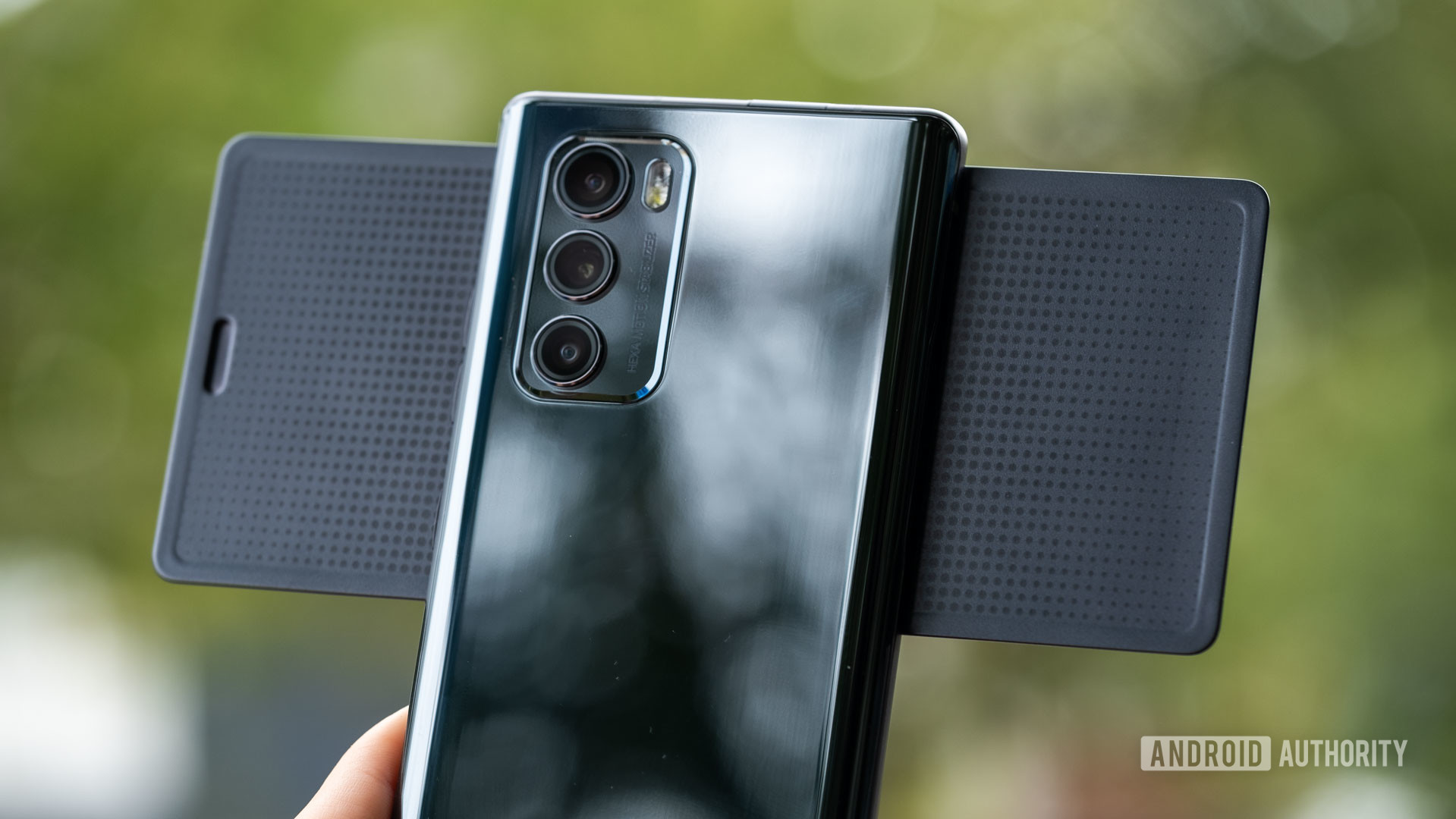
Due to the design of the swiveling display, a front-facing selfie camera wasn’t possible. That’s why the LG Wing has a pop-up selfie camera. As with other similar systems, it only pops out when you need it. When it does, a neat little animation occurs on the display, which is a subtle detail I appreciate.
On the side of the phone, you’ll find a volume rocker and a power button. All three buttons are the same exact size and feature a subtle curve. They are very clicky and feel well-constructed. However, a major design flaw is that, when in Swivel Mode, the main display covers up access to these buttons. It’s not impossible to get to them, but I found myself needing to turn the phone around so I could see them. Thankfully, software partially addresses this issue (which I’ll get to in a bit).
The design of the LG Wing is a slam dunk, which is quite notable considering it's a first stab at a new product.
Obviously, a swiveling smartphone display is going to have other disadvantages. There’s no IP68 rating here, but LG still was able to gain IP54 certification. That’s not going to allow you to go for a swim with the LG Wing, but it won’t fail on you in the rain, either.
You’ll also notice that there’s no headphone jack, a big omission for LG. Due to the limitations of the design, the headphone jack became a lower priority for this phone.
Regardless of what the rest of the phone can or can’t do, the LG Wing’s design is a marvel of engineering. For a first-run of new smartphone design, it’s pretty remarkable that the phone works as well as it does.
Displays: Not the best, not the worst
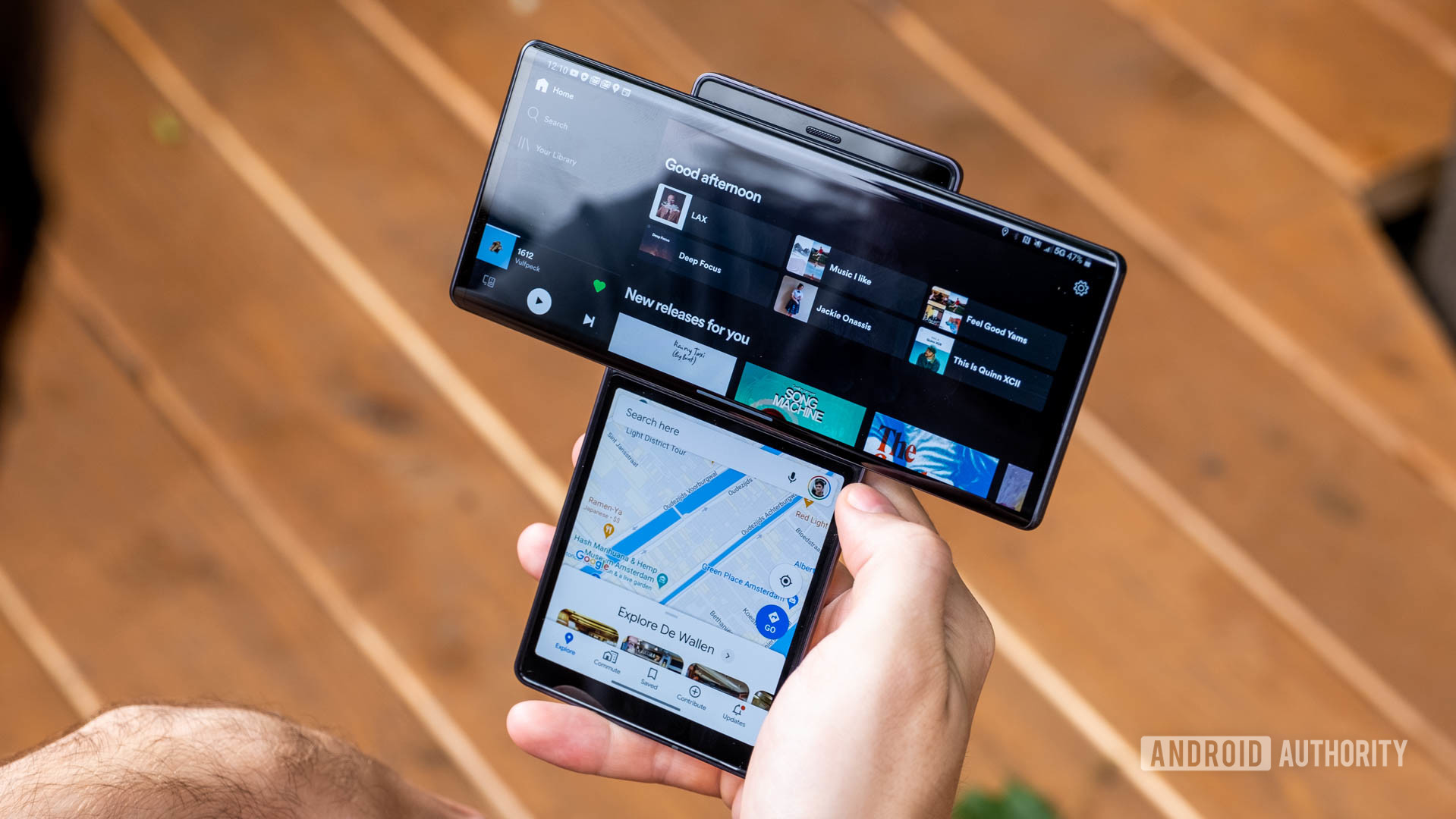
- Main:
- 6.8-inch OLED in a 20.5:9 ratio
- 2,460 x 1,080, 395ppi
- 60Hz
- Secondary:
- 3.9-inch OLED in a 1.15:1 ratio
- 1,240 x 1,080, 419ppi
- 60Hz
Chances are good that if you’re at all interested in the LG Wing, the dual-display design is the main appeal, not the raw specs of the displays themselves.
Nevertheless, both displays on the Wing are stuck at 1080p, which is unfortunate. They both also only offer 60Hz refresh rates. With most major releases offering at least a 90Hz panel or even up to 144Hz in some cases, a 60Hz display on a phone this expensive is definitely a mistake. LG could have gone for at least a 90Hz refresh rate on the main panel and left the smaller one at 60Hz, but oh well.
However, both displays are OLED with high pixel densities. Both panels get plenty bright with vibrant colors and deep blacks. You also have the usual controls over display quality that LG UX provides, with multiple display mode choices and the ability to fine-tune things like color temperature, saturation, and more.
The bottom line is that these aren’t bad panels by any stretch of the imagination — they just aren’t the best.
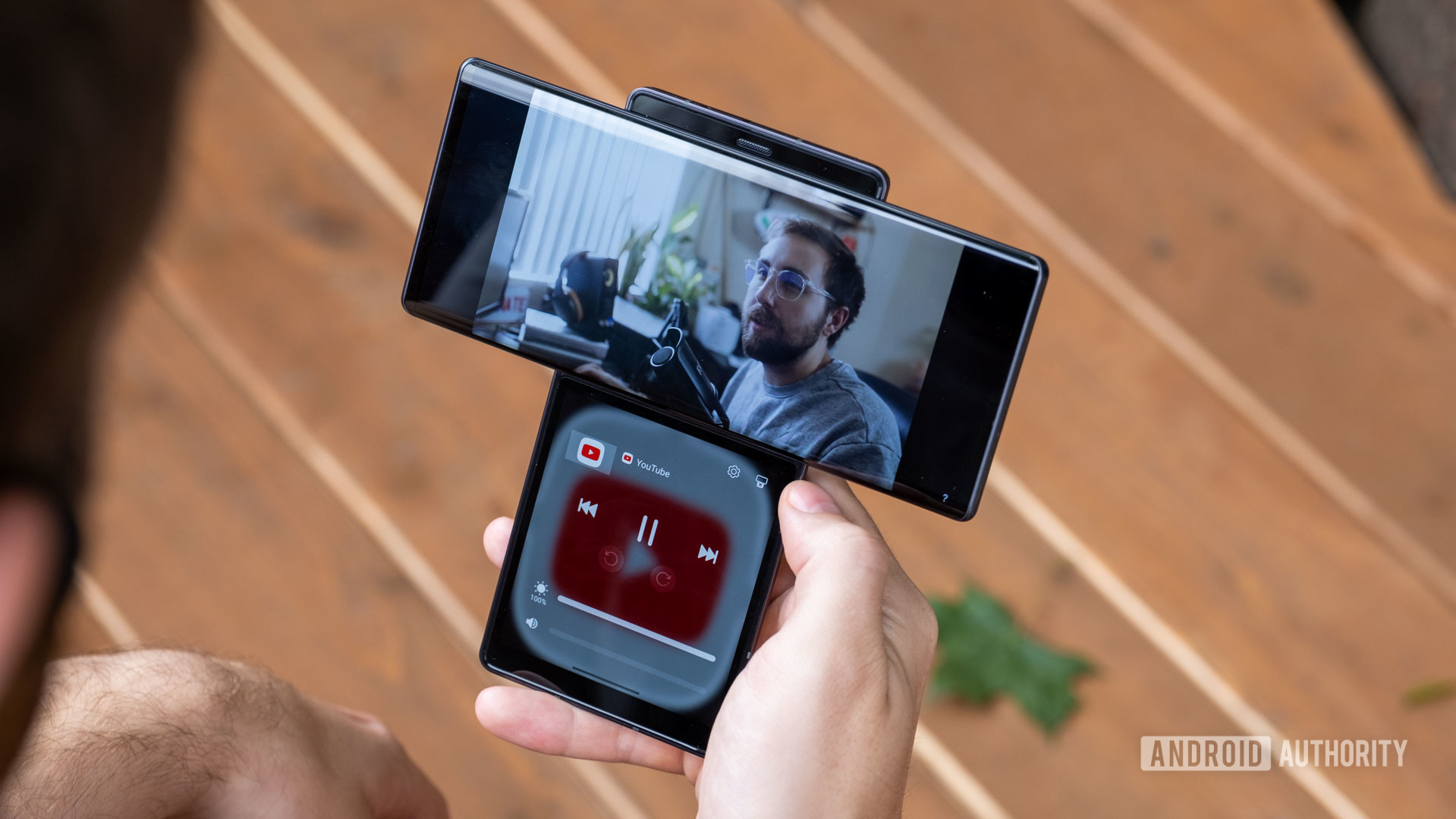
The main panel has curved sides, which gives the illusion that there are small bezels there. The forehead and chin, though, are both really thick and LG didn’t try to hide them. I’m sure the size of the top and bottom bezels are related to limitations with the swiveling display mechanism. However, it’s difficult not to wonder why the bezels couldn’t be smaller since there’s no speaker or selfie camera. There’s also no display cutout or notch.
The biggest complaint I have related to the display is the in-display fingerprint sensor. Compared to other phones with in-display sensors I’ve tested, the Wing is far slower and often required me to try a few times to get it to unlock.
Performance: A tad under-powered
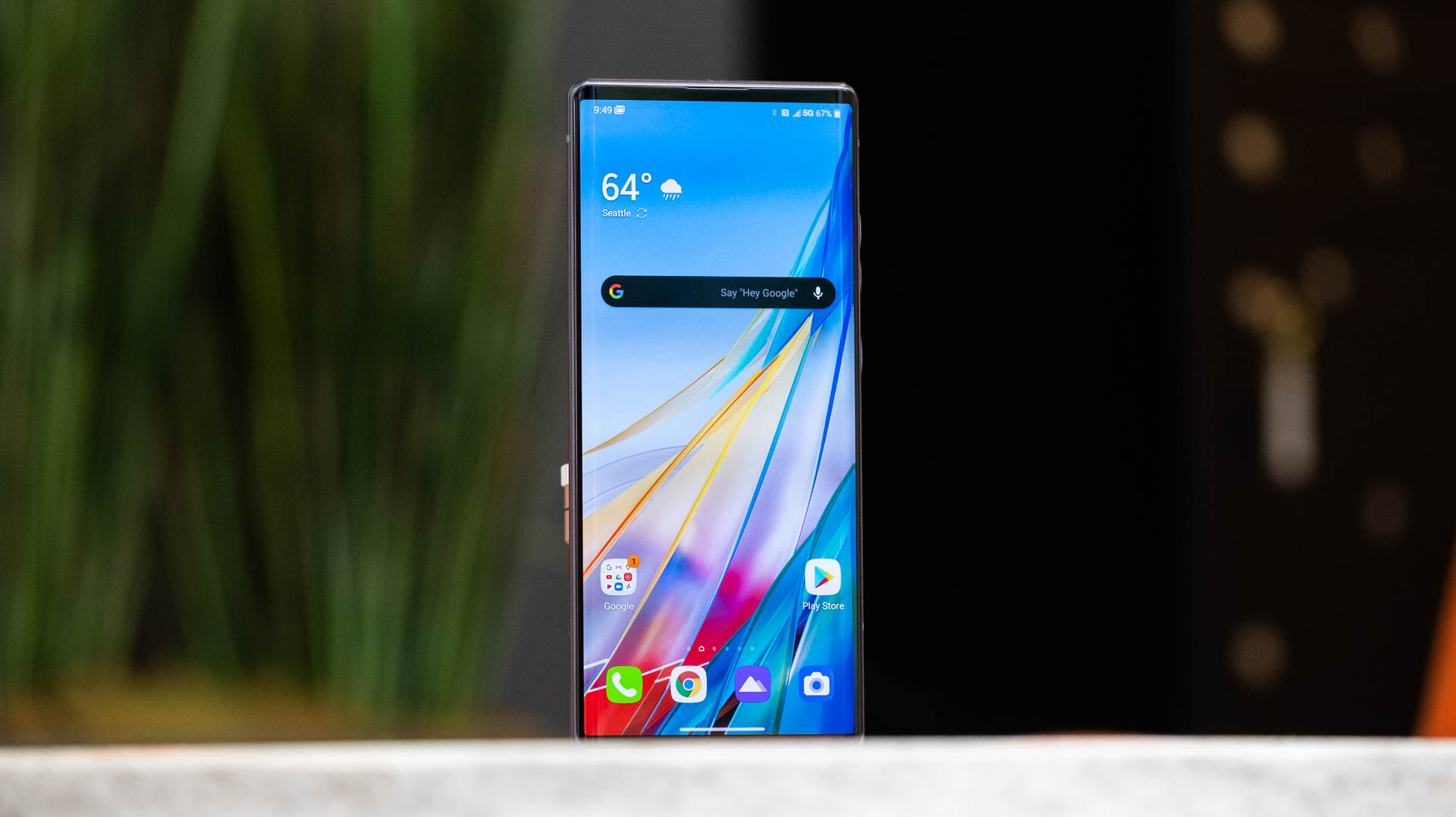
- Qualcomm Snapdragon 765G
- Adreno 620
- 8GB RAM
- 128GB or 256GB storage (expandable)
LG made a big to-do about the 5G capabilities of the Wing. While it does have both sub-6GHz and mmWave 5G support, it is powered by the Snapdragon 765G and not the 2020 flagship Snapdragon 865 (let alone the 865 Plus).
You’ll see in a lot of our reviews for 765G-powered phones that we say things like, “for the average user performing everyday tasks, the Snapdragon 765G will be more-than-capable.” While that is 100% true for the average 2020 smartphone, the LG Wing is hardly average. This phone should have a Snapdragon 865 chip.
The main problem is that the phone needs to power two displays. Those displays could be running two wholly different apps, which could require some substantial processing power. Even when you are operating in “A + a” mode (which means you are running an app on the main display and a smaller related app on the secondary one), you’re still running two apps. Because the LG Wing is such a new concept, there aren’t many apps that natively take advantage of the dual-display format. Instead, the app on the smaller display is usually something like an “applet” run through the Naver Whale browser.
See also: Snapdragon 765G vs Snapdragon 865
This puts an incredible strain on the chipset. I will admit that the Snapdragon 765G does well enough. I didn’t see any app crashes or debilitating slowdowns during my time evaluating the Wing. The time I spent playing Asphalt 9: Legends went smoothly. However, Android animations were choppy and launching apps caused a bit of a wait compared to what I’ve seen on Snapdragon 865-powered devices or even Snapdragon 855 phones.
Normally, future software updates and refinement of the dual-display experience could squeeze more power out of Qualcomm’s upper-mid-range chipset. However, with LG exiting the smartphone market, you shouldn’t expect significant refinements to arrive.
As it stands at the moment, the phone feels slightly underpowered — and you don’t need to go looking for it to feel it.
Battery: Those displays drink a lot of juice
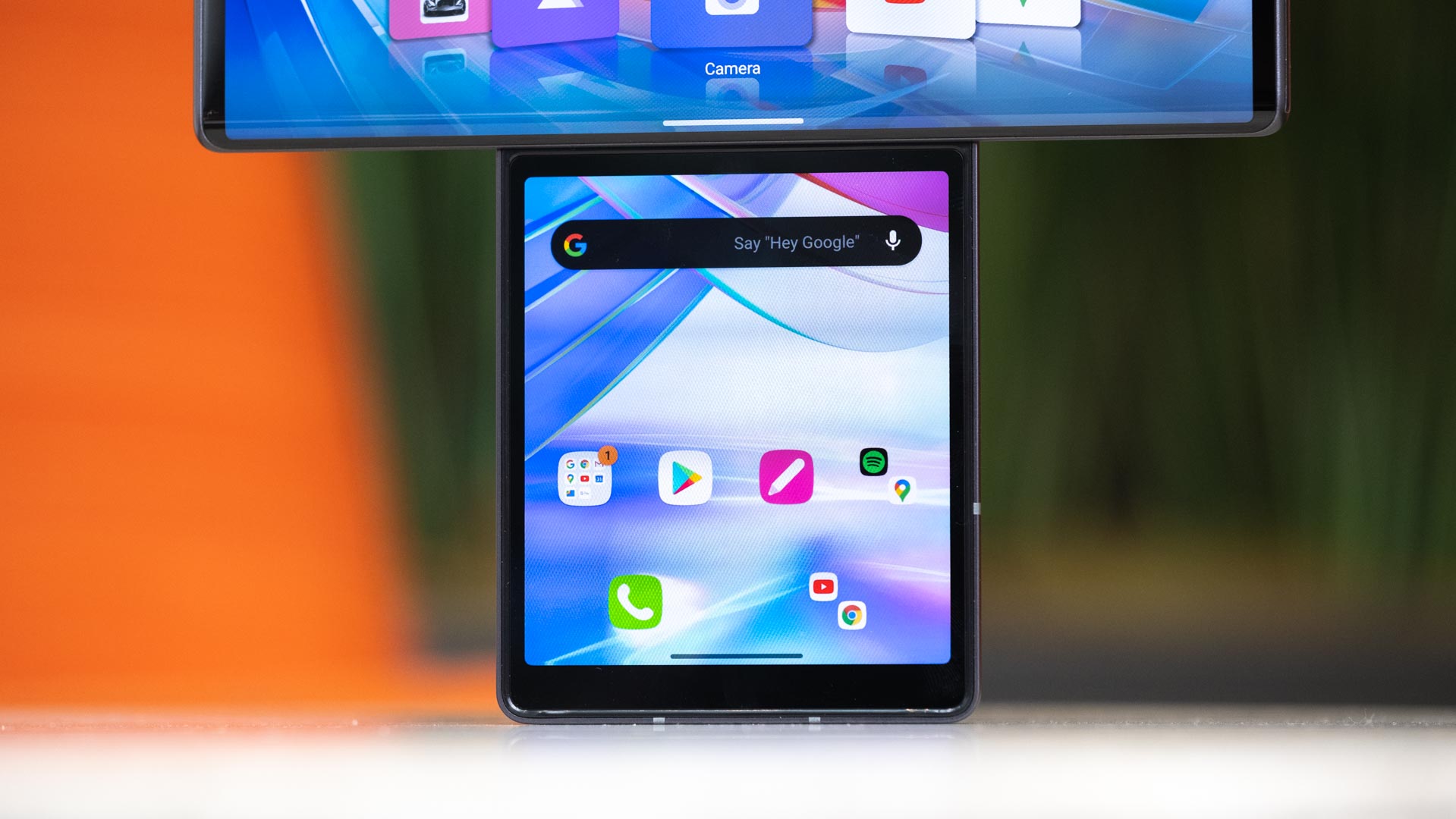
- 4,000mAh battery
- 25W USB Power Delivery
- Wireless charging
At 4,000mAh, the battery in the LG Wing isn’t enormous — but it isn’t tiny, either. As you’d expect from a cell that size, my battery life experience with the Wing was average. In one run, I got about 5.5 hours of screen-on-time over about a day-and-a-half of light-to-moderate use in both Swivel Mode and Basic Mode. That stacks up with a lot of other phones we’ve seen this year, such as the Google Pixel 5. However, it pales in comparison to something like the ASUS ROG Phone 3, which has an enormous 6,000mAh battery (and just one display).
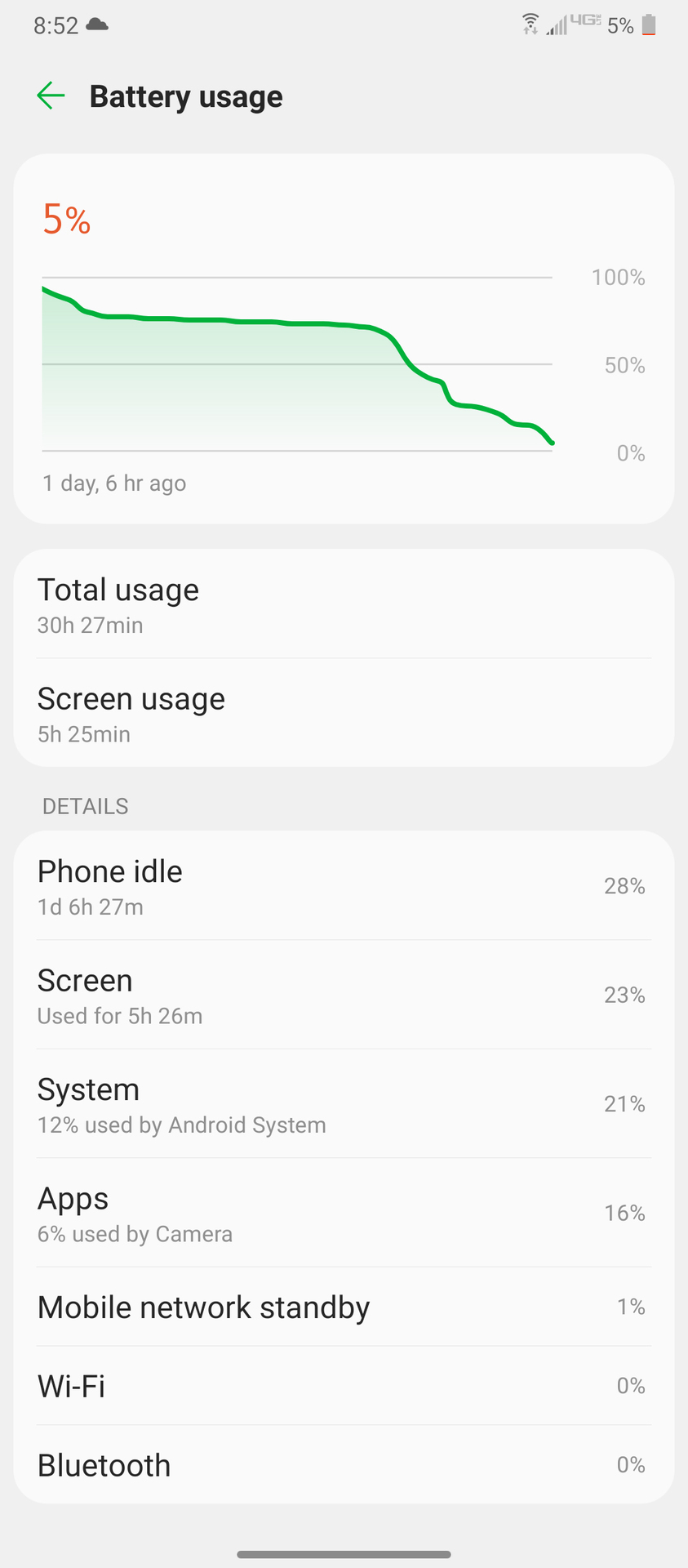
Ultimately, your battery life is going to heavily depend on how much you’re using Swivel Mode. When the phone is in Basic Mode, the secondary panel underneath the main display is (obviously) dark. As such, if you mostly use Basic Mode, the battery will only be powering the main display, which will result in a decent amount of life.
On the other hand, if you use Swivel Mode a lot, the battery is going to need to power the main display and the secondary display. Considering the secondary panel is the same quality and nearly half the size of the main panel, battery life could suffer significantly.
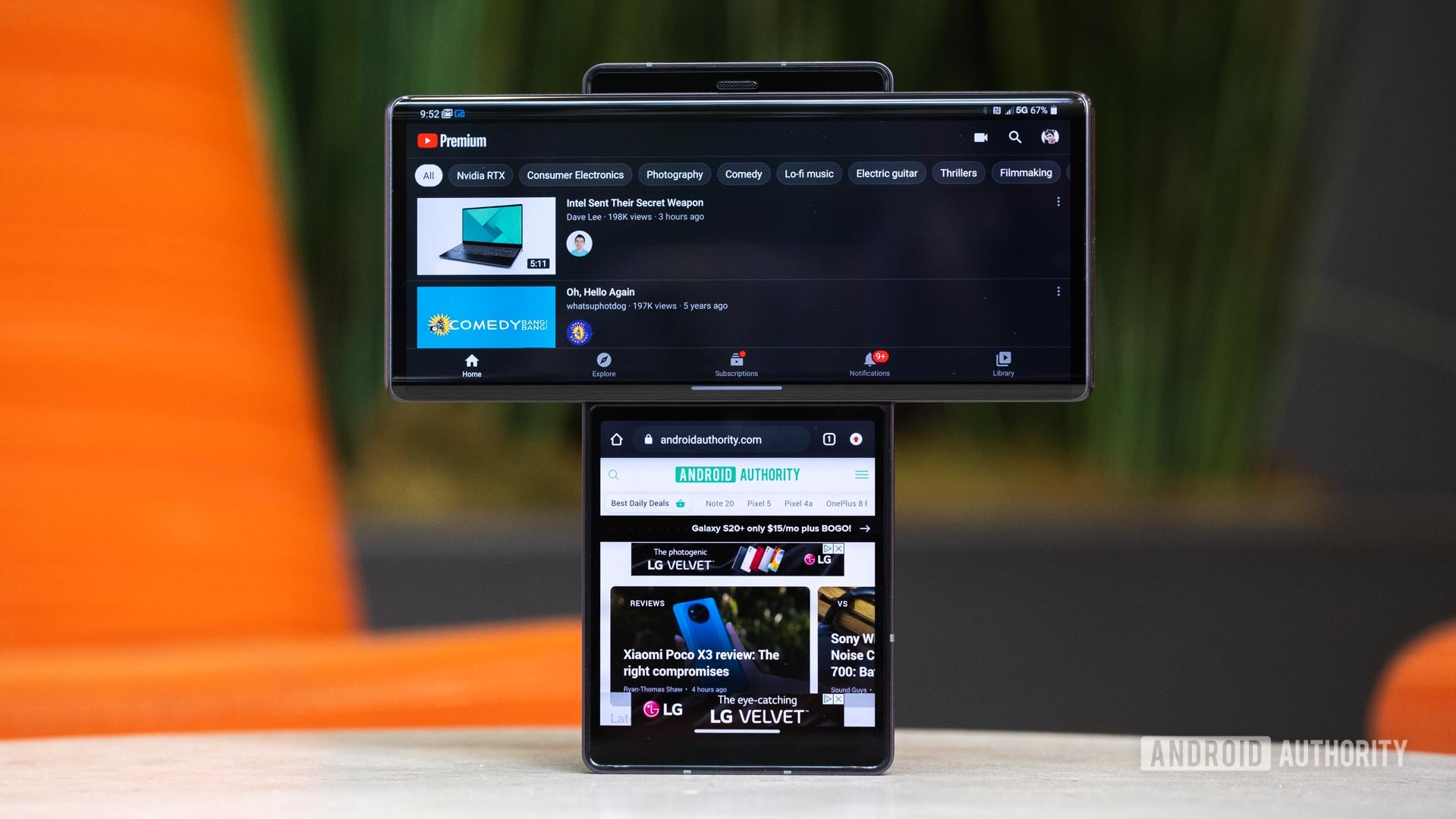
As an experiment, I played this 30-minute YouTube video on the phone in Basic Mode (screen closed). The battery went down by 3%. I then played the same video for the same 30-minutes in Swivel Mode and the battery went down by 5%. Those results aren’t unexpected and illuminate the issue here.
All in all, though, I was pleasantly surprised by the battery life of the LG Wing. Recent LG phones have fared well when it comes to power consumption — with the LG V60 being of particular note — so it’s likely LG passed on some of those battery-conservation skills to the Wing. I would feel comfortable relying on the LG Wing as a daily driver phone that comes off the charger in the morning and goes back onto the charger at night with plenty of Swivel Mode usage in there.
Speaking of charging, the Wing will charge at a rate of 25W with the in-box charger and its USB-C-to-USB-C cable. It can also charge wirelessly at a peak rate of 12W. Using the wired charger, it took me about 75 minutes to charge it from zero to full. However, it doesn’t feature reverse wireless charging.
Camera: For videographers only
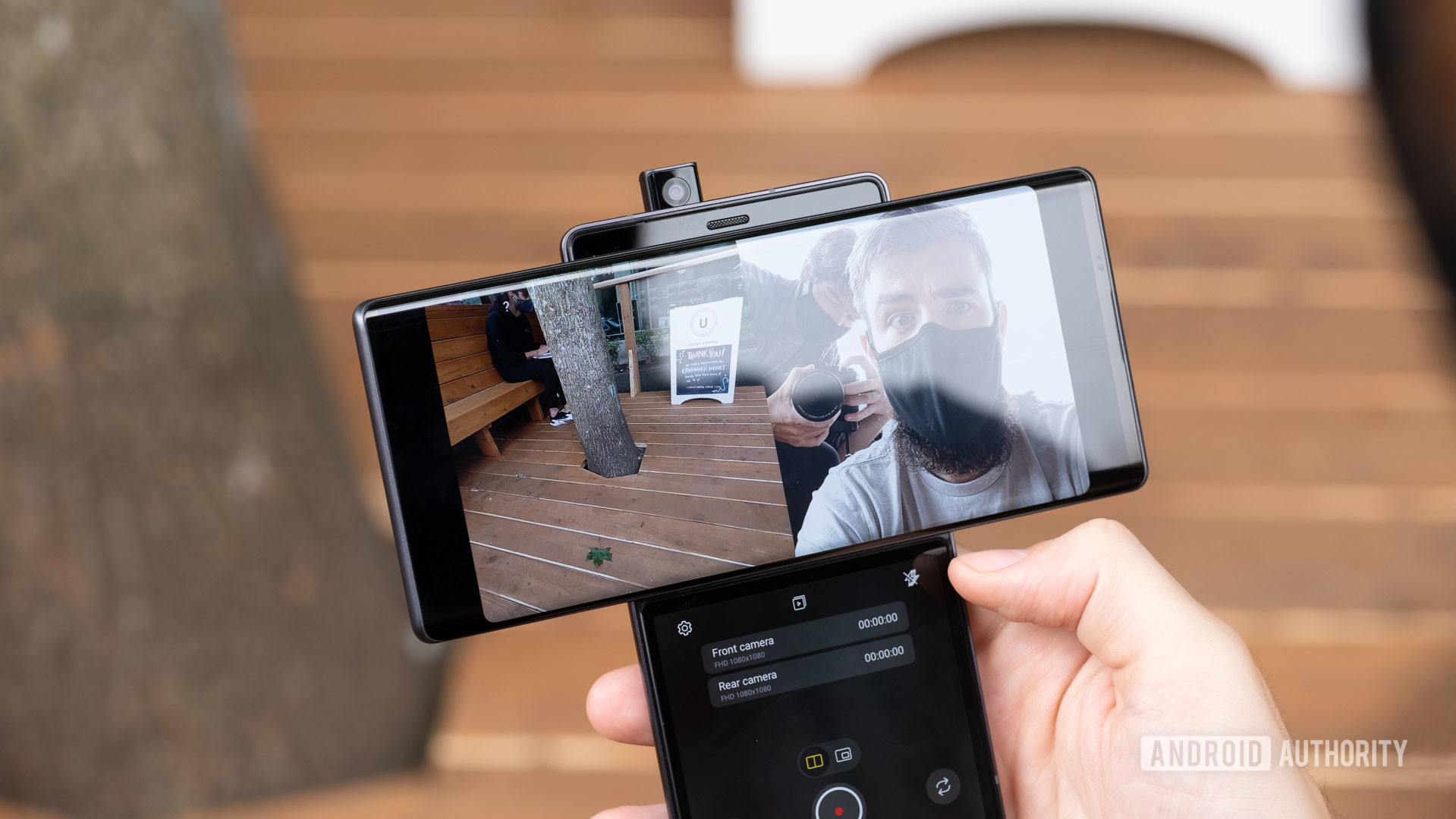
- 64MP OIS EIS wide (ƒ/1.8, 0.8μm, 78-degree FoV)
- 13MP ultra-wide (ƒ/1.9, 1.0μm, 117-degree FoV)
- 12MP ultra-wide (ƒ/2.2, 1.4μm, 120-degree FoV)
- Front: 32MP wide (ƒ/1.9, 0.8μm, 80-degree FoV)
- Video: 4K at 60fps, 1080p at 60fps
It’s been a while since LG was even in the running for any of our Best of Android lists related to cameras. As such, it’s not surprising that the camera system here is only so-so for photos. It’s not bad by any stretch of the imagination, but I wouldn’t recommend it to serious shutterbugs either.
However, the unique form factor of the LG Wing does open up a new interesting use case as a pseudo gimbal. LG smartly leaned right into this and created a whole gimbal mode for the camera when you operate in Swivel Mode.
I’ll get to that in a second. For now, check out some of the photos I captured with the LG Wing. First, here are just some standard shots using the main sensor. You can see that colors are a bit washed out and details can be a bit mushy.
Notice how the fur of my two cats kind of blends into a fur-like mass with all the details lost. In all these photos, the only color that really pops is the green pole with the pedestrian button, and that is way overcompensated (the pole isn’t that green).
The Wing has a unique setup on the back with a primary lens and then two ultra-wide-angle lenses. The reason for this is because one of the ultra-wide lenses operates in Basic Mode and the other operates in Swivel Mode. Here is how the Basic Mode ultra-wide fares as compared to the standard shooter and 2x optical zoom.
Obviously, the gray weather and the bleak imagery don’t help show off this camera’s charm, but the differences between how each image looks are pretty striking. The lighting difference between the ultra-wide shot and the zoom shot is like night and day.
The two aspects where the LG Wing camera surprised me as far as photography goes is with Night View and the selfie camera. The first photo below is of my bedroom in the daytime with all the windows open. The middle photo is my bedroom at night with all the blinds and curtains closed. The last photo is Night View in action under the same conditions as the middle photo. That Night View shot is pretty impressive, considering how dark the room was.
Finally, the selfie camera was actually pretty cool. The Portrait Mode of the selfie camera looks very artificial and I didn’t care for it, but just taking a normal selfie produced great results.
Ultimately, the photography capabilities of this phone just aren’t great. However, as I mentioned earlier, it does have a trick up its sleeve when it comes to videography.
If you use the phone in Swivel Mode, the normal camera app vanishes and a new video-only app opens. On the bottom display, a gimbal controller interface pops up. You can then grip the bottom display with one hand and use your thumb to mimic gimbal controls while you record landscape-oriented video using the main display as your viewfinder.
For videographers, this will be huge. Recording video in landscape mode with just one hand is never good — no matter how much stabilization is present, the footage always looks shaky. But, with your hand gripped at the center of the phone’s mass and the LG Wing’s stabilization features, you can get some really stunning results.
Below, you’ll see side-by-side footage of me running with the camera. On the right, I was running while cradling the phone in Basic Mode in my right hand. On the left, I ran at the same pace but with the phone in Swivel Mode in my right hand. The results speak for themselves.
Outside of smooth gimbal-like footage, the Swivel Mode camera app has a few other tricks up its sleeve. You can record video simultaneously with the pop-up selfie camera and the rear camera. What’s more, you can choose to save each file separately for editing later. You can even save one file with the rear footage as the main video and the selfie camera footage in a box at the lower right corner.
Essentially, the LG Wing can be a videographer’s dream. Obviously, the camera isn’t the best here, but the dual-screen format totally changes the game when it comes to recording video with a smartphone. Now, to get silky smooth video footage, you don’t need to carry around a cumbersome gimbal — just flip into Swivel Mode and start shooting.
Software: Plenty of tricks, but not enough polish
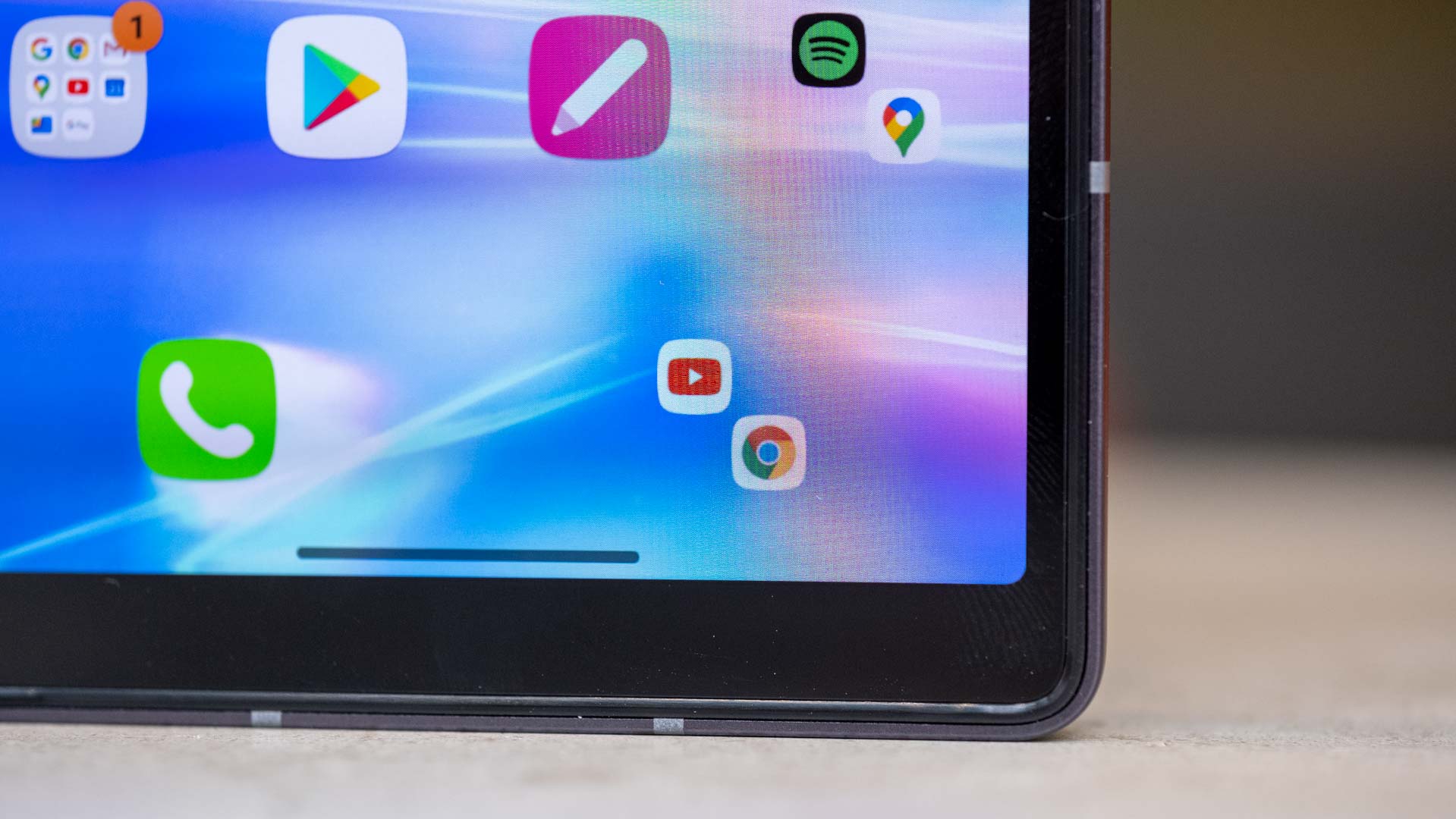
- Android 10
- LG UX 9.0
Let me get this out of the way: personally, I’m not a huge fan of LG UX 9.0. It strikes me as a weird hybrid of Samsung’s One UI and OPPO’s Color OS. It’s not horrible or anything, but it’s not exactly my favorite Android skin. This is totally subjective though, so your opinion might differ.
Related: Are there any truly bad Android skins out there today?
Whether you love or hate LG’s UX is pretty important when it comes to the LG Wing, though. I say that because you’ll be using the software features a lot more than you likely would on other Android phones. With other phones, if you’re not a huge fan of the included skin, you can just install a new launcher and tweak it to your liking. With this, though, you are going to rely on LG UX for the majority of the Swivel Mode features.
There are plenty of features here, too, even on top of the gimbal-related features I talked about in the previous section. First, let me explain the basic principle behind how LG approaches Swivel Mode apps:
- A + a — In this mode, you’re running an app on the primary display and then an “applet” that controls or otherwise interacts with it on the secondary display. The gimbal camera feature in the previous section is a perfect example of this. Only certain apps will support this mode.
- A + B — In this mode, you’re running an app on the primary display and then a completely different app on the secondary panel.
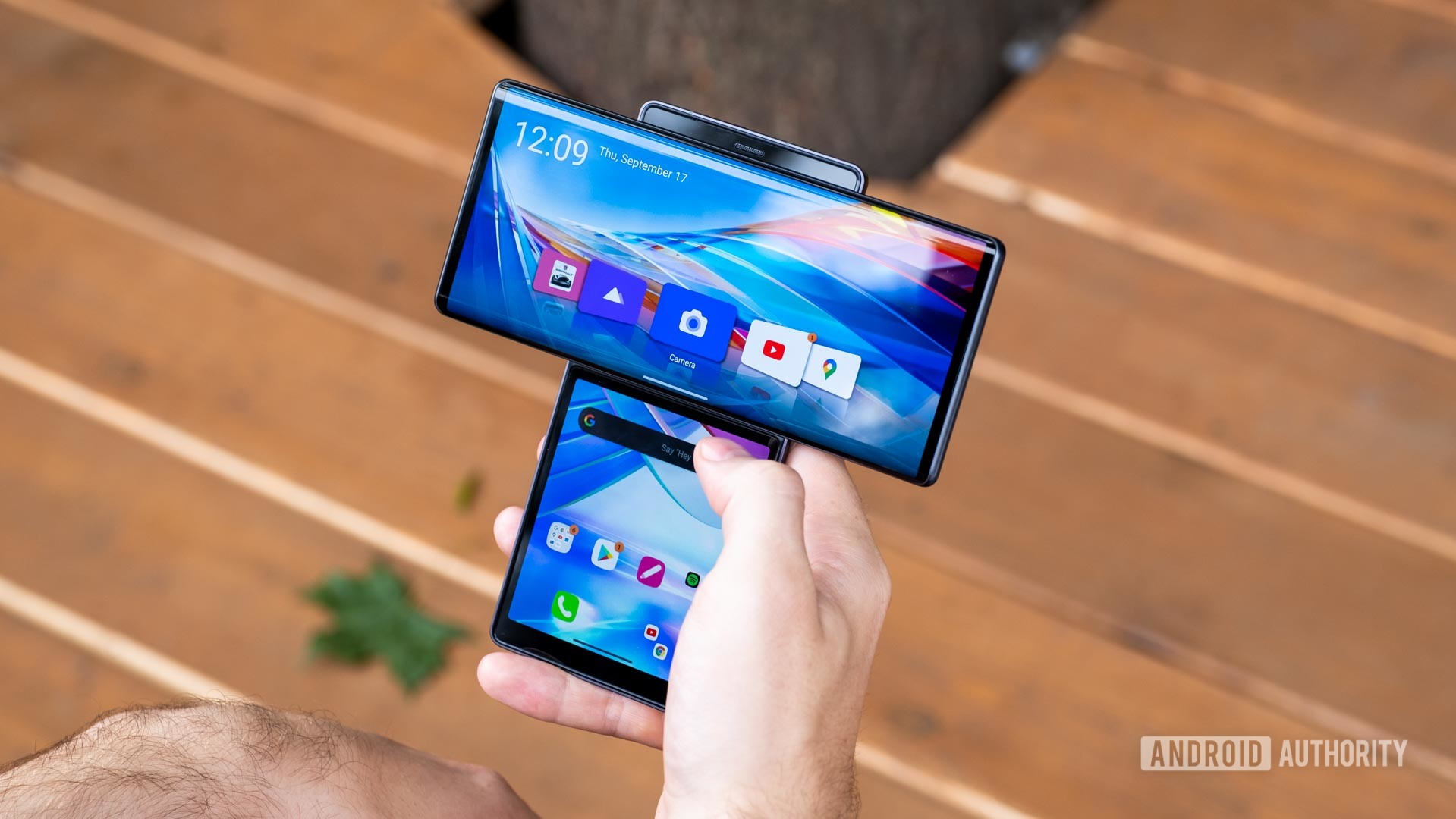
Out-of-the-box, there are five apps on the LG Wing that support “A + a” features: the camera, the gallery, YouTube, Google Maps, and the racing game Asphalt 9: Legends. In the case of YouTube, in “A + a” mode, the video you’re watching will appear on the main display while controls for that video appear on the bottom. This includes a volume slider, which addresses my previous issue with the hardware buttons being hard to hit in Swivel Mode.
When LG launched the phone, it was likely other apps would eventually support “A + a” features on the Wing. I can think of so many potential use cases here, such as Netflix using a similar setup as YouTube, YouTube Music showing a music video up top, and then lyrics and other info on the bottom, etc. However, with LG exiting the smartphone industry, most of these ideas will never come to fruition.
The “A + B” mode is much easier to support. As long as an app is capable of working on a nearly-square 3.9-inch display, it will work in the “A + B” mode. This mode is a multitasker’s dream. It allows you to, for example, watch a YouTube video up top while tweeting about it on the bottom. Conversely, you could flip the whole device around and play Fortnite on the larger screen while Spotify plays on the smaller one above it.
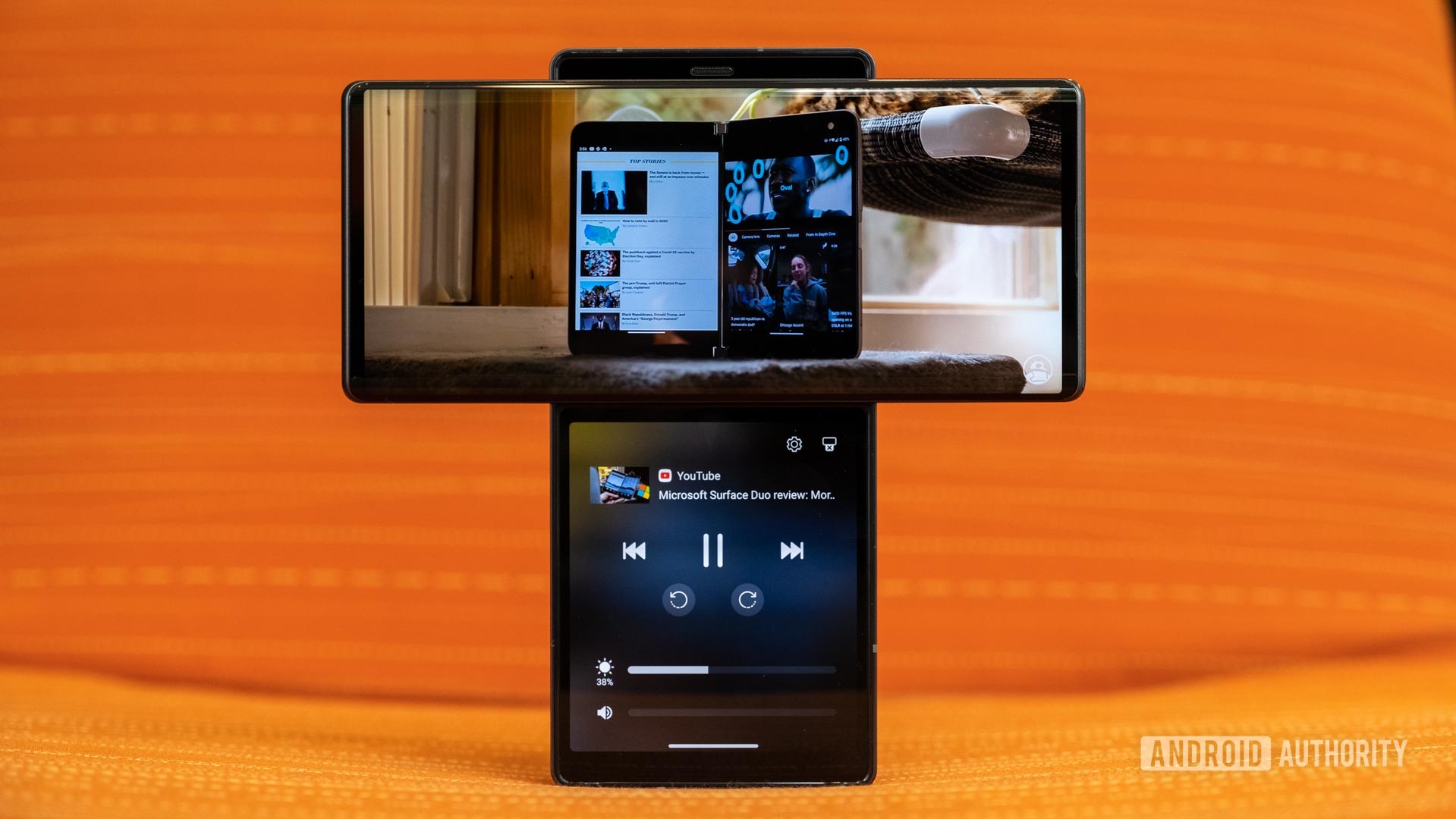
For gamers, a cool feature on the Wing is Game Tools. It automatically appears on the secondary display when you start playing something on the main screen. It shows a bunch of control toggles to enhance your experience. For example, you can disable notifications, adjust graphics settings, and even take a screenshot. You can also quickly hit the “Search in YouTube” button which pulls up search results for that game on YouTube without interrupting your play session. Now, you can watch an explainer video and play your game at the same time.
LG also incorporates a really useful software tweak for “A + B” mode that allows you to pair two apps together in a launcher icon. Once you set it all up, you can hit the shortcut and it will automatically open both apps on the proper screens. This is a sweet system and really shows the potential of the Wing.
The software on the Wing shows off the potential of the dual-display design. The keyword there is 'potential.'
Unfortunately, all of these features are fairly confusing. In Swivel Mode, the bottom display becomes its own thing, meaning your interactions with that display don’t affect the top display. If you didn’t go through the steps of setting up a launcher shortcut, it can be cumbersome to find the app you want for the small display and then navigate through the top display to find the other app you want to run in tandem. At one point, I launched an app on the main display in Basic Mode, opened the Wing into Swivel Mode, and then realized I wanted that app on the main display to be on the secondary display. I sighed and went through the process of trying to get that app to the other screen.
We saw similar problems during our review of another 2020 dual-screen phone, the Microsoft Surface Duo. Because Android has only rudimentary native features for dual-display phones, OEMs need to solve problems like these on their own. While LG does a pretty good job of showing the potential of the Wing when it comes to software, it will probably always fall a bit short without native Android support.
LG Wing specs
| LG Wing | |
|---|---|
Display | Main: 6.8-inch OLED 2,460 x 1,080 resolution 20.5:9 screen ratio 60Hz refresh rate Secondary: 3.9-inch OLED 1,240 x 1,080 resolution 1.15:1 screen ratio 60Hz refresh rate |
Processor | Qualcomm Snapdragon 765G |
GPU | Qualcomm Adreno 620 |
RAM | 8GB |
Storage | 128/256GB Expandable with microSD card (up to 2TB) |
Battery | 4,000mAh battery Quick Charge 4+ Wireless charging |
Cameras | Primary: 64MP sensor, ƒ/1.8 aperture, 0.8μm pixels OIS, 78-degree FoV Secondary: 13MP ultra-wide sensor, ƒ/1.9 aperture, 1.0μm pixels, 117-degree FoV Tertiary: 12MP ultra-wide sensor, ƒ/2.2 aperture, 1.4μm pixels, 120-degree FoV, Gimbal Motion Camera Front (pop-up): 32MP sensor, ƒ/1.9 aperture, 0.8μm pixels |
Connectivity | 5G (both mmWave and Sub-6) Wi-Fi 5 Bluetooth 5.1 NFC |
Durability | IP54 certified Protected from limited dust ingress Protected from water spray from any direction |
Operating System | Android 10 |
Audio | LG 3D Sound Engine No 3.5mm port |
Dimensions and weight | 169.5 x 74.5 x 10.9mm 260g |
Colors | Aurora Gray, Illusion Sky |
Value for money
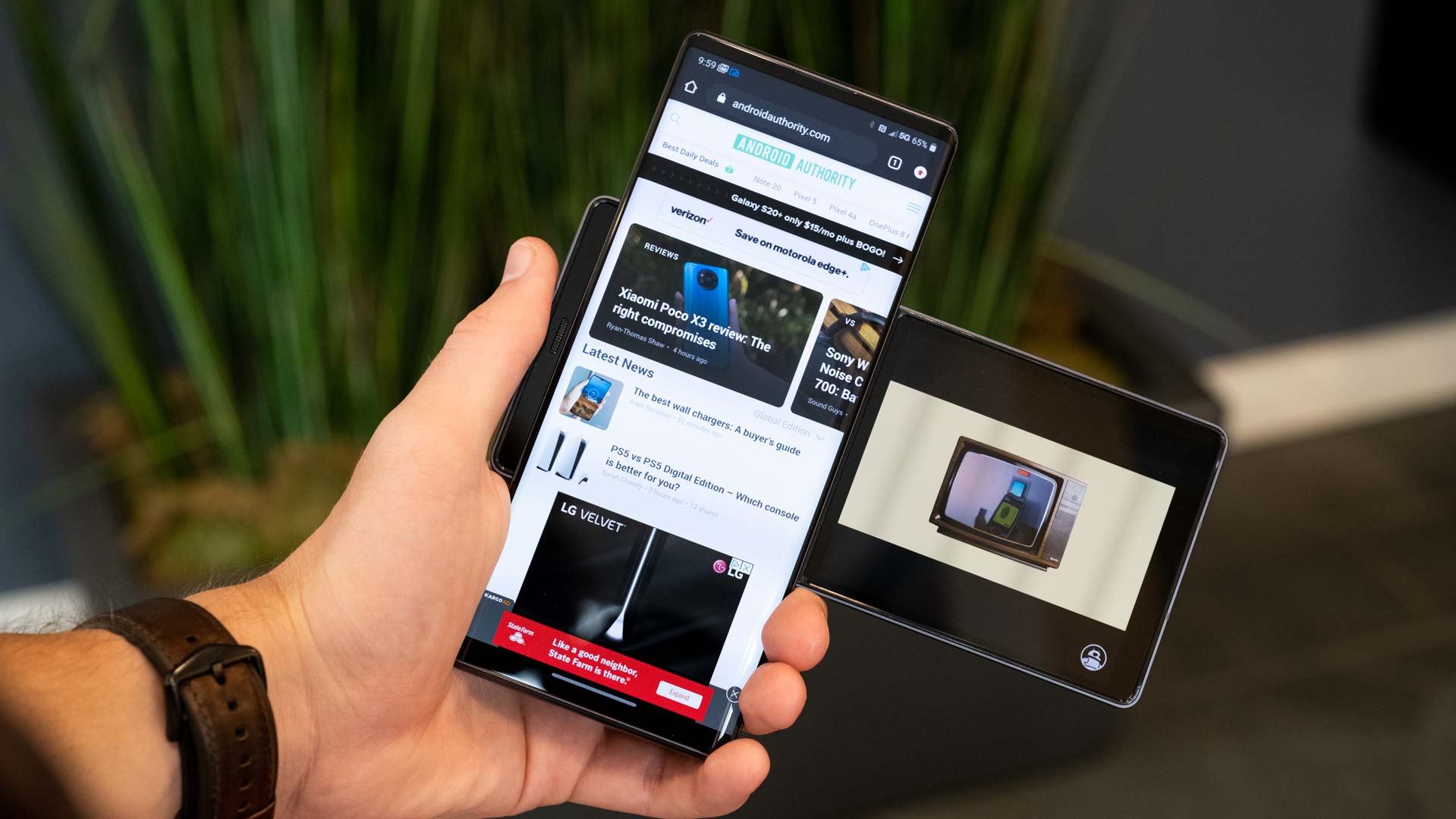
- LG Wing (8GB/256GB) — $999
If you only looked at the specs table in the previous section and then looked at the price tag here, you would laugh hysterically. A 2020 Android smartphone with a Snapdragon 765G, no IP68 rating, no ultra-fast wired charging, a 4,000mAh battery, and a 1080p 60Hz display for $1,000? What is LG thinking?
Obviously, though, the LG Wing is so much more than the sum of its specs. This is an entirely new form factor; a brand new way of thinking about what a smartphone is and what it can do. The physical engineering of the device alone makes it worth a lot more money than something like the Google Pixel 4a 5G or OnePlus Nord.
In a way, the LG Wing is not too dissimilar from the original Samsung Galaxy Fold. On paper, the Galaxy Fold wasn’t a top-tier device when it came to specs and features, either. The appeal of the Fold, though, was the fact that it pushed the boundaries of smartphone construction and allowed folks who want to be on the bleeding edge to try out a new toy. And that phone was twice as expensive as the LG Wing.
Ultimately, I feel the Wing is adequately priced. Sure, if you’re looking for a mid-range phone with mid-range specs and a mid-range price, this isn’t for you. If you’re the kind of buyer who loves early adoption and wants to try out something that may or may not be the future of phones, then $1,000 is likely a bargain to you. It’s certainly a bargain compared to the Galaxy Fold at launch, let alone the even more expensive follow-up, the Galaxy Z Fold 2.
Obviously, with LG’s exit of the smartphone industry in 2021, it’s a lot easier to find the Wing for much less than its $999 MSRP. Unfortunately, LG never released an unlocked version of the phone. That means you’ll only be able to find carrier-locked variants.
LG Wing review: The verdict
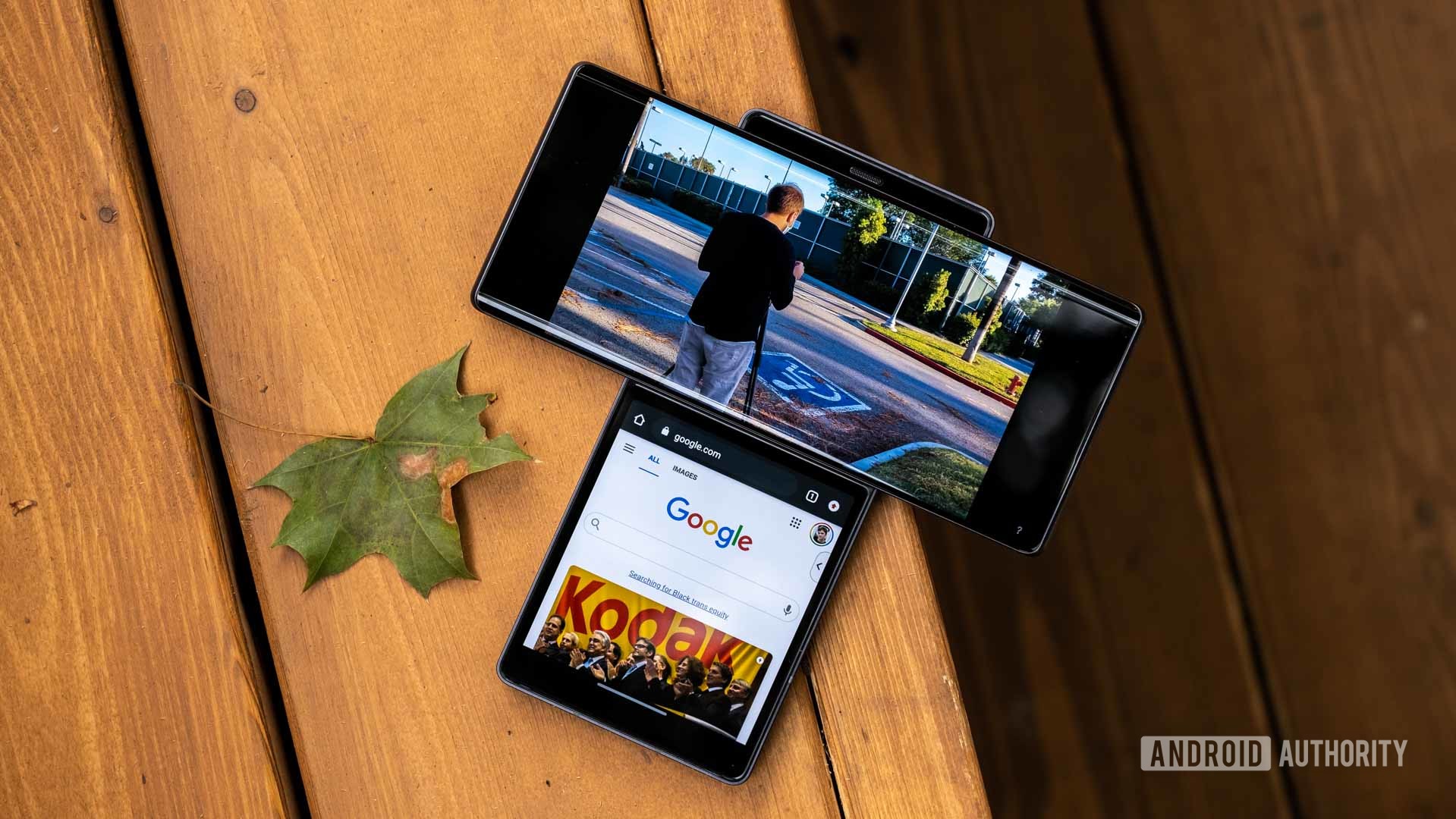
It’s been over a year now and the LG Wing is still one-of-a-kind. It did not change the smartphone industry, and LG’s exit from the market entirely means it never will. However, of the devices I saw in 2020 that throw out the current rule book and try something different — the Microsoft Surface Duo, the Galaxy Z Fold 2, the Galaxy Z Flip, etc. — the Wing seemed to be the most practical. To me, this form factor is the one that I would carry around in my pocket if a dual-screen experience was something I desperately needed.
That being said, I don’t feel that a dual-screen phone is essential to my life. In my time with the Wing, the only use case that really spoke to me as being much better than what I can achieve with any “normal” smartphone is the gimbal videography mode. However, that’s not enough for me to carry around a heavy, thick, $1,000 phone with mid-range specs.
What excited me the most about the Wing was its potential. If LG could have made the phone slimmer and lighter as well as beef up the specs to give it the power and polish it deserves, the Wing would have been mighty tempting. It’s unfortunate, then, that we’ll never see a Wing 2.
That’s a wrap on our LG Wing review. What do you think of LG’s first Explorer Project phone?